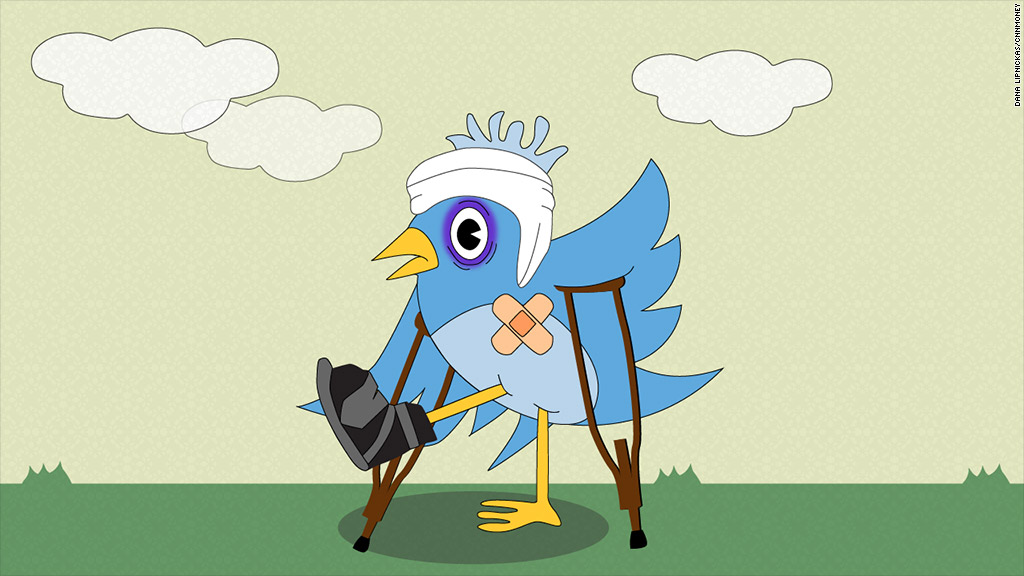
Twitter was the place to be for snarky commentary about the GOP debate on Tuesday night. Search for "Princess Buttercup" and "Punched the Russians in the nose" and you won't be disappointed.
Want instant reaction to those phenomenal reviews for "The Force Awakens" early Wednesday morning? Check out Twitter. There's even an adorable BB-8 emoji for the #StarWars hashtag.
And what are all the market junkies and econonerds going to be doing later Wednesday afternoon? Live tweeting about the (likely) rate hike from the Federal Reserve and searching for deeper meaning in every word uttered by Fed chair Janet Yellen.
Yet none of this seems to matter to Wall Street. Twitter has failed to capitalize on the fact that it's the go-to social media platform for many celebrities, politicians and journalists during live events.
Shares of Twitter (TWTR) closed below $24 on Tuesday -- their lowest finish to a trading day ever. The stock is down 15% since Jack Dorsey took over as CEO in early October and has plunged more than 33% in 2015.
Twitter went public in November 2013 at a price of $26. Needless to say, it's not a healthy sign when the stock goes below the offering price. And some analysts think it will get worse. Evercore ISI's Ken Sena cut his target on Twitter earlier this week to $22.
Why is Twitter slumping? It has many loyal users who are actively engaged. I consider myself to be one of them.
Related: Twitter still hasn't found its groove
But overall user growth has slowed. The company had 320 million active monthly users as of the end of the third quarter, up just 1.3% from the second quarter. That's a big problem.
Scale matters in social media. Facebook (FB) has it -- and not just with Facebook. It also owns Instagram and WhatsApp.
Snapchat is also starting to catch up to Twitter in terms of users and few would be surprised if it eventually passed Twitter.
Dorsey has admitted on numerous occasions that the big challenge is attracting new people to sign up and use the service. For the uninitiated, Twitter can be -- in the words of Jimi Hendrix -- a frustrating mess.
The company is trying to become more user friendly.
Twitter launched a new Moments feature in October -- a curated series of tweets about big news, pop culture and sports events. Twitter even ran a TV ad campaign to promote it during the World Series.
It controversially changed its star icon that people used to Favorite a tweet to a heart icon that showed you Like a tweet. The move ticked off Twitter diehards but was clearly made to try and be more like Facebook.
Related: Twitter ditches stars and favorites for hearts and likes
And in perhaps the biggest move of all, Twitter is experimenting with a new way of showing tweets in their users' timelines. Currently, it's in reverse chronological order. That's great if you are following breaking news.
But it also means that higher quality tweets get buried in a deluge of new ones. Recency trumps relevancy.
Will all these changes lead to more active users? That remains to be seen. But interestingly, Twitter is also trying to make more money from so-called unregistered or logged-out users.
Twitter announced last week that it was testing an expanded use of Promoted Tweets from advertisers.
Instead of targeting them solely to registered users, Promoted Tweets will be able to be viewed by people who see a tweet when they go to Twitter without logging in and by those who have tweets pop up in search results on Google (GOOGL).
Twitter revenue product manager Deepak Rao wrote in a blog post that when you include these logged-out users, Twitter has another 500 million people visiting it each month.
Related: Jack Dorsey apologizes to developers
That's all well and good. But Twitter won't be able to convince a skeptical Wall Street that it can get back on track unless it is able to convert those people to become active users.
Martin Pyykkonen, an analyst with Rosenblatt Securities, wrote in a report last week that Twitter needs more casual users and not just the "seemingly dedicated and maybe even cult-like base of active users."
Pyykkonen said Moments could help in this regard. So could Periscope -- the live streaming video app it bought earlier this year.
So expect a lot more changes from Twitter as it seeks to build its user base.
In order to succeed, Twitter needs to be like that indie rock band you loved when you saw them in a club that held 100 people but hated once they started selling out basketball arenas. Twitter has to go mainstream. Or else.


